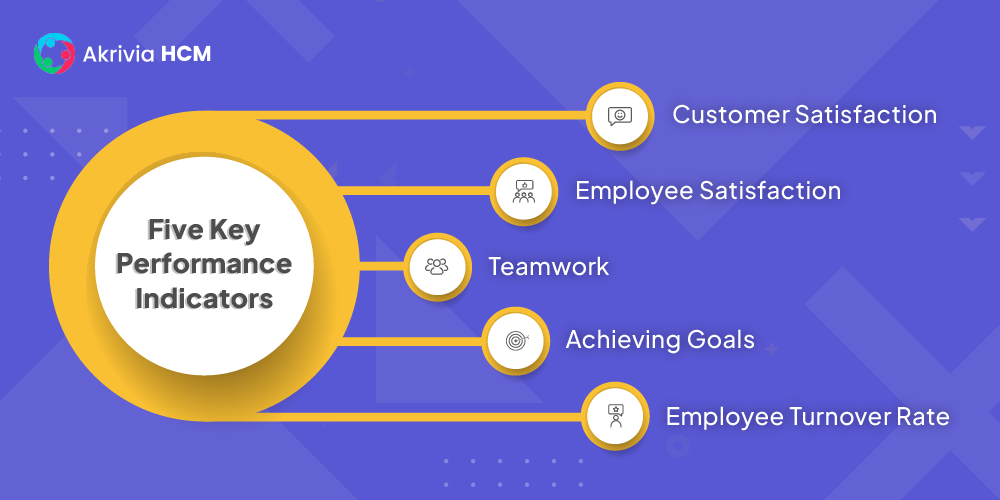Table of Contents
Key Performance Indicators (KPIs) are a system of benchmarking key success metrics that organizational leaders use to drive performance improvement over time. KPI metrics help management monitor how efficiently the business is being run and how it stacks up against similar organizations.

There are many methods of judging the quality and success of a workforce. Anybody can pick a few, but if you want to be more formal about your employee performance evaluation process, you should be aware that there are five key performance indicators.
When you are trying to evaluate the success of your business, it is essential to look at these factors:
KPIs are used to measure performance and track progress. It can use them for individual goals or team goals. They can take the form of numbers, ratios, or percentages.
Numbers:
Numbers are objective measurements that can track using tools like spreadsheets and databases. Examples: the number of calls made, number of products sold, amount of time spent on a project, and number of people that completed an assignment.
Ratios:
Ratios compare two numbers side by side. Ratios are denoted with two numbers side by side, separated by a colon (e.g., 2:1 ratio). It allows the observer to compare the two numbers and their relation. Examples: Number of inbound versus outbound sales calls, In-store purchases compared to online purchases.
Percentages:
Percentages elaborate on counts by dividing the number of people or things that exhibit a target characteristic by the total population size. This number is multiplied by 100, thus the name per (by) cent (one hundred). Example: Percentage of employees that have completed a training program.
A Key Performance Indicator is a performance metric directly related to business objectives.
On the other hand, a metric is a class of quantifiable data relevant to an organization’s standard business processes. A metric typically is not tied to a strategic objective. For example, “the number of widgets” might be an appropriate metric when evaluating the efficiency of a widget manufacturing process. While there may be a specific goal associated with this metric (e.g., producing ten widgets per hour), it does not necessarily contribute directly to meeting that goal in most cases.
There are some ways to answer this problem. You can make a decision based on the KPI. Or you can use the data to determine how to solve it. You may have a lot of KPIs, but you don’t have to use all of them.
First, you have to establish a clear objective for your KPI, then outline the criteria for success. You need to know who will be responsible for completing this KPI and when they will receive feedback on their performance.
Then you go out and collect the data required to measure performance against your criteria for success. This part is pretty straightforward: tools such as Excel allow you to build formulas and create calculations with test data. This step will help guarantee that your formulas deliver the results you expect.
Finally, all that’s left is to present your KPIs in an easy-to-understand format so that everyone can see how well they’re doing at any given time.
The time to review your KPIs is when you are in the middle of a project or end. It should be right before the beginning of a project and right after it. This way, you can be sure your goals are clear. The time should also be in line with your goal’s timeframe concerning short-term and long-term goals. If you have a one-year plan, your reviews should occur every quarter. If it’s a quarterly goal, you can review it at the end of each month.
You don’t need dozens of metrics. Typically, three or four KPIs or key performance indicators are enough. You can have more if you have multiple stakeholders with conflicting goals or various perspectives on one goal. But for most plans, three to five KPI metrics are plenty.
Three is the ideal number: one for each major stakeholder group and one to represent the goal itself. If you have more than three stakeholders (customers, employees, investors), then use another KPI to track the total value created by your organization.
KPIs are important because they measure performance, which can be linked to a company’s smart goals. Without quantifying key performance indicators, it would be hard to honestly know if a company is moving forward or backward in its progress.
KPIs are vital because they provide the business owner with crucial information about the overall well-being of the company. Through KPIs, the business owner can keep up with current happenings in his business and make necessary changes to keep the company profitable and thriving.
KPIs are continuity tools because they provide a long-term vision for the company. They allow for evaluating different strategies and changes in plans that may take place over the years. In addition, KPIs provide a way to compare the past with present results to analyze how far a company has come since its foundation.
In conclusion, many companies would fail without KPIs due to not having enough information about their business’s performance. It should analyze key performance indicators immediately to determine what is causing the problem and how to fix it whenever there is an issue within a business. Performance management software can help companies implement and manage their KPI systems more efficiently.
Let’s Recruit, Reward, and Retain
Your Workforce Together!
